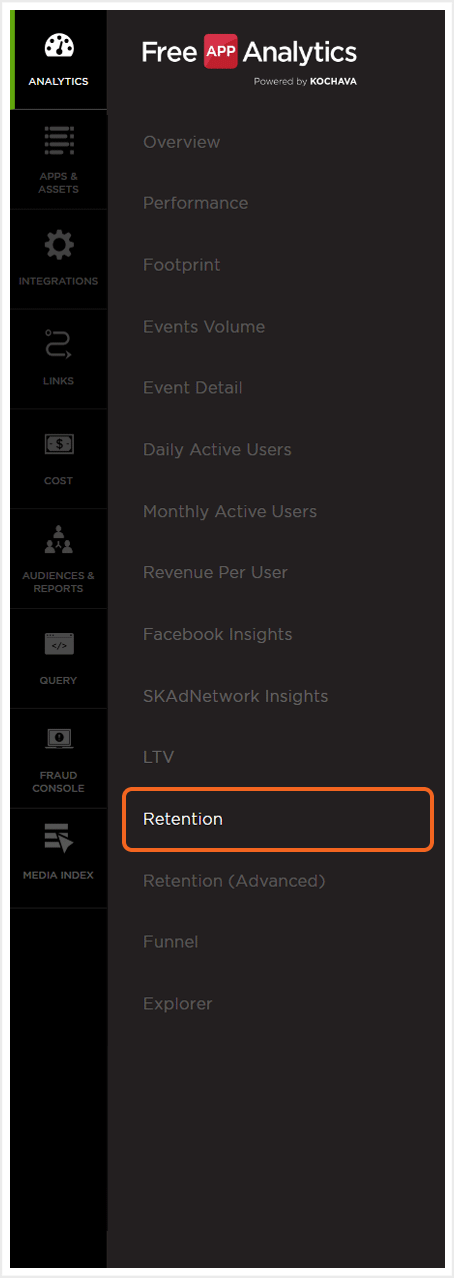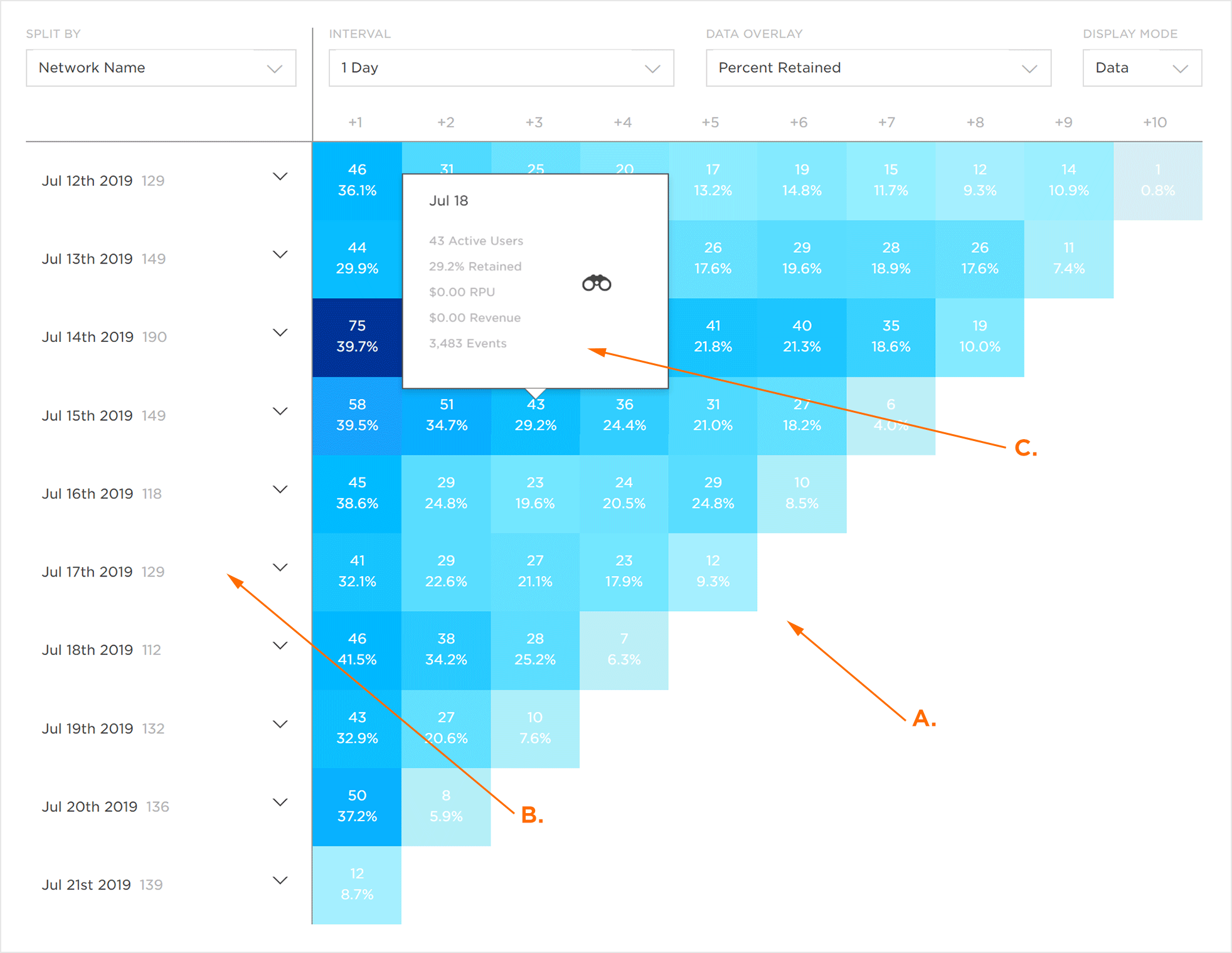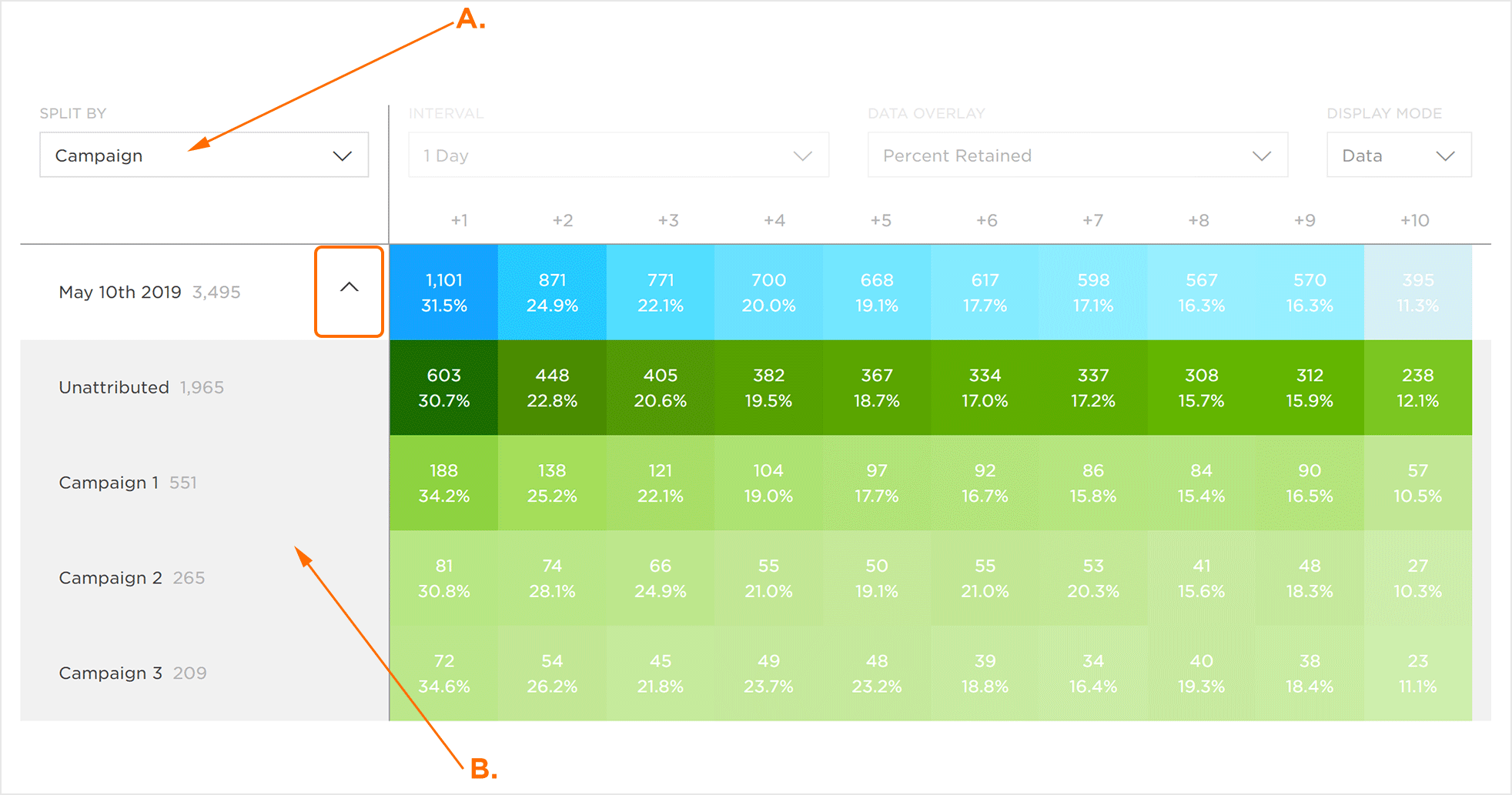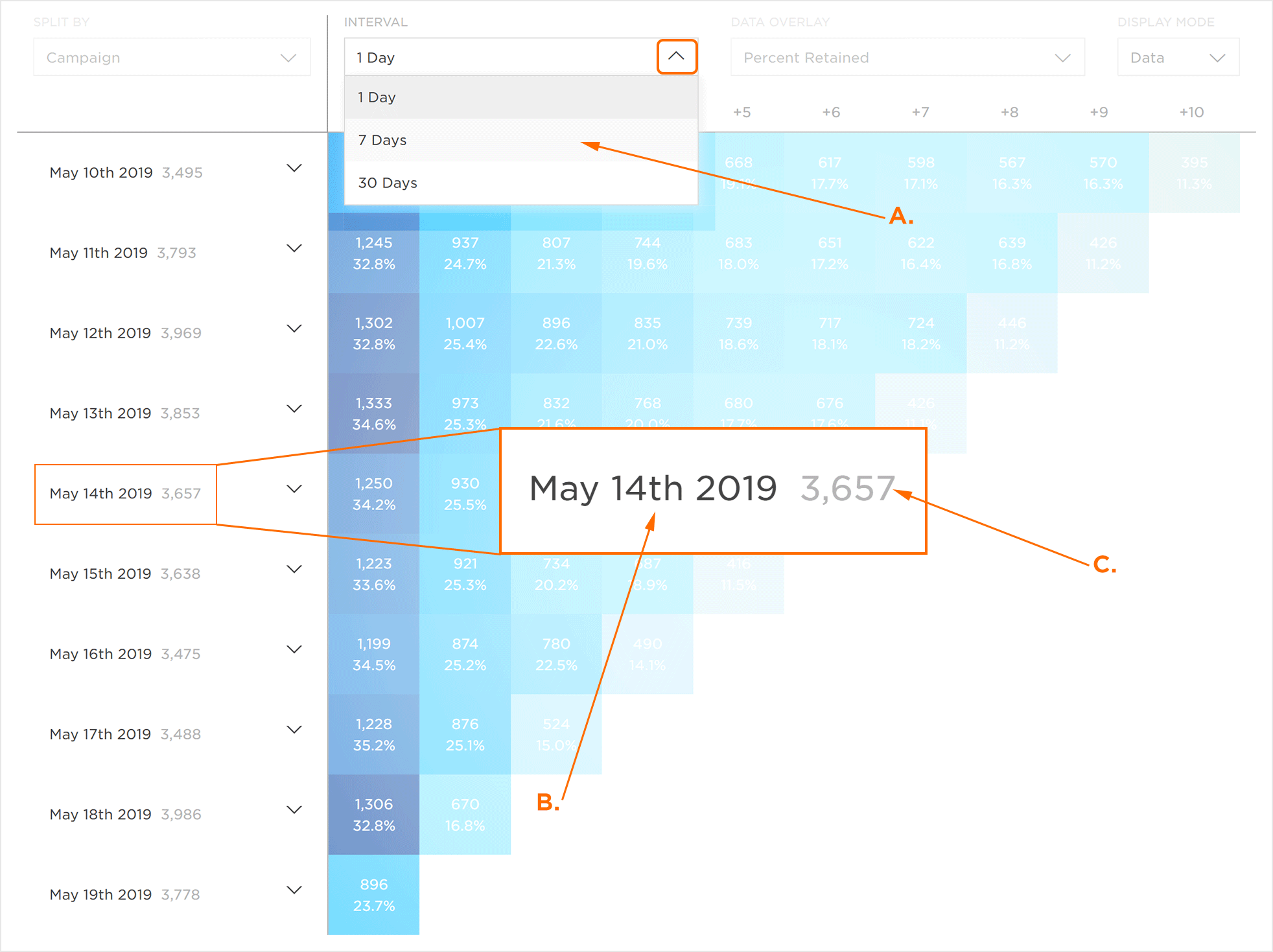The Analytics Retention page provides a visualization of the retention of Installs, RPU (Revenue per User), Revenue, and events for a selected timeframe.
Analytics Interface
- Log in to Free App Analytics.
- Select the desired Account and App.
- Select Analytics > Retention.

Analytics Page Tools
For more information about the tools that can be used on the Analytics page such as date range, filters, sharing the page and exporting device ID, refer to our Analytics Page Tools support documentation.
NOTE: The Cohort Date set represents the end-date used to define the retention view.
Retention Chart Overview
The Retention chart is divided into 2 main sections, the dates within the selected time interval and the graphical display of retention in either data or chart form.
Mousing over any data blocks/chart within the display will show the Date, RPU, Revenue, and Events for the specific data block or chart.
NOTE: When leveraging Cross App functionality, the retention data for all apps within the App Name filter will be displayed. Retention data may be displayed for each app by utilizing the split by feature. For more information on viewing retention data by app, refer to the Retention Organization section. For more information about adding apps using the filter feature, refer to our Analytics Page Tools support documentation.

A. Graphic display of Retention data
B. Dates within timeframe
C. Mousover Data
NOTE: Data within the graphic display is color coordinated. The darker the color represents the higher the retention rate. The retention of each day (e.g., +1, +2, +3) is a subset of the initial install count and not a subset of the day prior.
Retention Organization
Retention data can be organized in many different ways in order to assist in the optimization of data visualization.
- From the Split By drop-down menu, Select one of the following:
- App
- App IdKochava-specific ID of the app. If selected, data will be organized under each corresponding app ID.
- App NameUser generated name of an app. If selected, data will be organized under each corresponding app name.
- App VersionUnique version name or numeric value that represents the unique state of the app. If selected, data will be organized under each corresponding app version.
NOTE: In order to use the App split by feature, the desired apps must be added utilizing the filter feature. For more information about adding apps using the filter feature, refer to our Analytics Page Tools support documentation.
- Campaign
- CampaignInstall or Post-Install - User generated Campaign Name. If selected, data will be organized under each corresponding campaign name.
- CreativeInstall or Post-Install - Typically an image or video, Kochava receives the creative ID upon install or event. If selected, data will be organized under the corresponding creative ID.
- SegmentInstall or Post-Install - User generated name for a group within a campaign. If selected, data will be organized under each corresponding segment name.
- TrackerInstall or Post-Install - User generated name for a tracker within a segment and campaign. If selected, data will be organized under each corresponding tacker name.
- Device
- Device Carrier NameInstall or Post-Install - The cellular service provider (e.g., Verizon, AT&T). If selected, data will be organized under each corresponding carrier name.
- Device LanguageInstall or Post-Install - The primary language set for the device. If selected, data will be organized under each corresponding language code (e.g., en-US, zh-CN).
- Device Network Conn TypeInstall or Post-Install - The device connection type (e.g., WIFI, Cellular). If selected, data will be organized under each corresponding network connection type.
- Device OrientationInstall or Post-Install - The physical orientation of the device with respect to gravity (e.g, Landscape, Portrait). If selected, data will be organized under each device orientation.
- Device OsInstall or Post-Install - The mobile operating system that is installed on the device (e.g., iOS, Android). If selected, data will be organized under each corresponding operating system.
- Device Os VersionInstall or Post-Install - The unique version number for the operating system (e.g., iOS-10.3.3, Android-8.0.0). If selected, data will be organized under each corresponding operating system version.
- Device TypeInstall or Post-Install - The description of the device that install or post-install event is attributed to (e.g., SM-G935V-Verizon, iPhone8,1). If selected, data will be organized under each corresponding device type.
- Device VersionInstall or Post-Install - The device hardware version (e.g., iPhone-iOS-11.3, Samsung SM-N950U-Android-7.1.1). If selected, data will be organized under each corresponding device version.
- Location
- CityInstall or Post-Install - The name of the city where the click, install or post-install event occurred. If selected, data will be organized under each corresponding city.
- CountryInstall or Post-Install - The 2 digit country designation where the click, install or post-install event occurred. If selected, data will be organized under each country.
- DMAInstall or Post-Install - The designated marketing area where the click, install or post-install event occurred. If selected, data will be organized under each corresponding dma.
- RegionInstall or Post-Install - The 2 digit region designation where the click, install or post-install event occurred. If selected, data will be organized under each region.
- ZipInstall or Post-Install - An alpha numeric representation of the particular postal area where the click, install or post-install event occurred. If selected, data will be organized under each corresponding ZIP code.
- Attribution
(see iOS 14+ restrictions)
- TypeInstall - The type of attribution (e.g., Unattributed, Install). If selected, data will be organized under each corresponding attribution type.
- Install CampaignInstall - The install campaigns associated with the app. If selected, data will be organized under each corresponding install campaign.
- Install CreativeInstall - The creative associated with install. If selected, data will be organized under each corresponding install creative.
- Install Matched ByInstall - The device ID type by which the install was matched (e.g., idfa, ip, probabilistic). If selected, data will be organized under each corresponding install match type.
- Install Network NameInstall - The name of the newtork to which the install was attributed. If selected, data will be organized under each corresponding network name.
- Install SiteInstall - The site to which the install was attributed within the publisher partner. If selected, data will be organized under each corresponding site.
- Install TrackerInstall - The tracker name to which the install is attributed. If selected, data will be organized under each corresponding tracker name
- Matched ToInstall - The identifier to which attribution was matched (e.g., idfa, iad, adid). If selected, data will be organized under each attribution identifier.
- Matched ByInstalls and Post-Install - The method to which attribution was matched (e.g., click, impression, unattributed). If selected, data will be organized under each corresponding attribution method.
- Network NameInstall Post-Install - The name of the network to which attribution was awarded. If selected, data will be organized under each corresponding network name.
- Network IdInstall or Post-Install - The Kochava-specific ID of the network to which attribution was awarded. If selected, data will be organized under each corresponding network ID.
- Network Key
- Partner Ad Group IDInstall or Post-Install - The Kochava-specific ID of the ad group to which attribution was awarded. If selected, data will be organized under each corresponding ad group ID.
- Partner Ad Group NameInstall or Post-Install - The name of the ad group to which attribution was awarded. If selected, data will be organized under each corresponding ad group name.
- Partner Campaign IdInstall or Post-Install - The unique numeric identification for the partner campaign. If selected, data will be organized under each corresponding partner campaign ID.
- Partner Campaign NameInstall or Post-Install - The name of the partner campaign to which attribution was awarded. If selected, data will be organized under each partner campaign name
- Partner KeywordInstall or Post-Install - The partner keyword for the campaign which was awarded attribution. If selected, data will be organized under each corresponding keyword.
- Partner PlatformInstall Post-Install - The name of the partner digital platform to which attribution was awarded (e.g., facebook, display, messenger). If selected, data will be organized under each corresponding platform.
NOTE: For more information about how the Partner fields map to SAN metadata, please refer to our SAN Networks Campaign Data Mapping support documentation.
- QR CodeInstall - A boolean value (true, false) indicating if the installed was attributed to a QR Code. If selected, data will be organized under the boolean category.
- SiteInstall or Post-Install - The site to which the install or post-install event is attributed to (e.g., 3054, Facebook). If selected, data will be organized under each corresponsind site.
- Agency
- Agency NameInstall or Post-Install - The name of the agency to which the install or post-install event is attributed (e.g., MediaMath, AdParlor). If selected, data will be organized under each corresponding agency name.
- Agency IdInstall or Post-Install - The Kochava-specific agency ID to which the install or post-install event was attributed (e.g., 6702, 8577). If selected, data will be organized under each corresponding agency ID.
- Traffic Verification
- Traffic Verification Fail ReasonInstall or Post-Install - The traffic verifier metric which did not meet the defined condition and value (e.g., country, platform). If selected, data will be organized under each traffic verification fail reason.
- Traffic VerifiedInstall or Post-Install - Inidication whether the traffic has been verified or not. 1 indicates the traffic is verified, 0 indicates it was not verified. If selected, data will be organized under the traffic verified category.
- Locate the desired date and click the Data Expand Button.

A. Retention data organized into Campaigns
B. Campaigns active during the selected timeframe
NOTE: Data within the graphic display is color coordinated. The darker the color represents the higher the retention rate.
Organize by Interval
The date intervals are displayed along with the Install Count for the corresponding date along the vertical axis. Date intervals can be updated by selecting one of the following from the Interval drop-down menu:
- 1 Day
- 7 Days
- 30 Days
NOTE: By default, the last fully completed day will be the start date for the data within the Retention Chart.
Ten dates will be displayed in the vertical axis which correspond to the selected interval. The earliest date within the selected timeframe is displayed at the top of the list and the final date within the timeframe is displayed at the bottom of the list.

A. Interval from 1 Day to 30 Days
B. Date within the selected time interval
C. Install Count for day
The date interval is also represented along the horizontal axis at the top of the graphical display section corresponding to the selected interval (i.e. 1, 7 or 30).

A. Date + 1 = Mar 28th
B. Date + 10 = Apr 6th
C. Date +7 = Feb 3rd
D. Date +70 = Apr 6th
Data Overlay
The data that is shown within the graphic display may be updated to illustrate the different aspects of the retention within the app. The data displayed may be updated by selecting one of the following:
Data Overlay Drop-Down Menu:
- Revenue Per User
- Total Revenue
- Total Event Count
NOTE: By default, the retained Install Count and the associated percentage are displayed. When selecting one of the available overlays, the retained Install Count will remain.


A. Percent Retained
B. C. Total Revenue Overlay: Install count and Revenue for day
D. Total Event Count Overlay: Install count and Events for day
Display Mode
The graphical display section can be shown in different formats. To change the format of the data displayed within the graphical display, select one of the following from the Display Mode drop-down menu:
- Data
- Chart
NOTE: The color indicates active users. The darker the color, the higher the number of active users.
NOTE: The size of the hole within the donut chart indicates the selected overlay. For example, if the Total Revenue overlay is selected, the size of the hole indicates the amount of revenue. The smaller the hole, the higher the amount of revenue.
NOTE: By default, the data within the graphic display section is shown in the Data format.

A. Display in either Data or Chart format

A. Graph in Data format
B. Graph in Chart format
FAQ
-




The data in the retention analytics view is based on summary numbers to allow for reasonable render time and therefore have a statistical accuracy margin of 3-5%.
The retention views use Cohort Dates instead of the standard date range.














